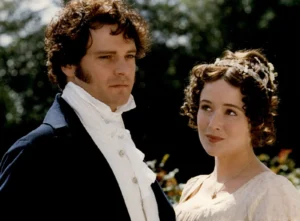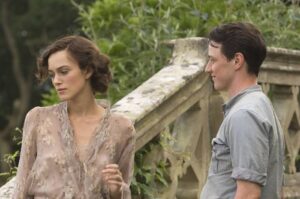There is beauty in his films bringing vivacity and vim to the classic stories that makes you go back to seize it all.
British film director, Joe Wright is well known for his amazing filmography, giving attention to every detail, capturing beauty and nothing else. Wright has established himself as part of Hollywood’s pantheon of top directors with his rare ability to captivate audience. Mostly known for his great novel adapted movies (Pride and Prejudice, Atonement and Anna Karenina). Let’s dig in to revere and treasure Wright’s Trinity of period dramas.
Pride and Prejudice (2005)

PRIDE & PREJUDICE was Wright’s first feature film direction. It earned him a BAFTA Award for “Most Promising Newcomer’ and “Best Director of the Year’ from the London Film Critics Circle. The movie starring Kiera Knightley as Elizabeth Bennet and Matthew MacFadyen as Mr. Darcy with their perfect on screen chemistry presents the OG enemies to lovers much admirably (to mention the breathtaking location of Darcy’s first proposal, in the gardens of Rosings, near a Lake, inside an abandoned 18th century building, amidst thunderstorm).
Wright’s praiseworthy direction can be seen in the gloriously presented Lizzy and Mr. Darcy’s first dance at the Netherfield Ball, where Wright magically transforms the moment from a bustling society event to just the two of them waltzing. You must know, surely you must know, how ardently I love and admire this movie for its bewitching cinematography, graceful costumes designed by Jacqueline Durran, lively settings, dulcet soundtracks of patient classical piano and scores by Dario Marianelli, flawless casting and acting, and how can we forget one of the poetic scenes (the hand flex scene)? All the things that get you obsessed. A great adaptation of a great novel written by a great author.
Atonement

ATONEMENT, adapted from the novel by Ian McEwan. A tale of passionate love being broken apart when a 13-year-old girl, Briony (Saoirse Ronan), through her jealousy misreads her sister Cecilia (Keira Knightley) and the housekeeper’s son Robbie’s (James McAvoy) relationship, changing several lives. She seeks atonement as WW II rages around them. You can’t help but appreciate the talent and intelligence put behind all the moving parts of the art form of filmmaking to create such a complex yet delicate and devastating story. To touch on one aspect, Wright has worked with Cinematographer Seamus McGarvey, who has captured every frame in the movie like a classic oil painting. Music design of this movie is incredible, working with composer Dario Marianelli. As the film score emphasises every scene and sets the tone for the complex emotions it brings forward. From the clacking of typewriter, pacing the movement of the character to one of the iconic Steadicam shots in film history of five-and-a-half minute, that follows Robbie along the Dunkirk beach, we hear the elegy of Dunkirk score in the background mixing perfectly with the lament sung by the soldiers, reflecting the weary horrors of the day before the ships arrive, as his exhausted troopers stagger in to find not refuge but defeat and chaos.
Wright’s use of color and changes in color coding for characters also play an important role in the visual melodrama. Rich colors, touches of green, deep blues, and faded pinks that provide texture on screen, and the way the costumes of the actors complement and contrast with the set and theme make the story beautifully stick in our memory.
Anna Karenina

Making a valiant move by picking up the challenging Russian literature, Leo Tolstoy’s novel, ANNA KARENINA for adaptation, Wright has proved his beyond compare skills in art of filmmaking. Showcasing the high society of 19th-century Russia through the prism of a massive, well-worn theatre and the story staged like a theatre play. Trapped in a loveless marriage, aristocrat Anna Karenina enters into a life-changing affair with the affluent Count Vronsky. Although with the goal of discerning which does it better, the book or the movie, Anna Karenina movie got low reviews as it released. But rather it should be viewed as introducing a visual dimension to the story by using classical melodramatic elements like color, mirror, and music while maintaining its narrative. There are many admirable elements in the film to be noticed, the sumptuous set design, gorgeous costumes, choreographed ballroom dances and gestures, the delicate musical score by Dario Marianellis shifting from strings to sung (non-diegetic to diegetic) that allows the audience to explore emotions in the movie like hope, grief, anxiety through music. The sets changing in the theatre can be seen as flats flying in and out of scenes, with the idea allowing the audience to explore a new portal that opened in the classic story. On a personal note, my favorite visual scene in Anna Karenina is the bittersweet end of the movie. We see Karenin sitting peacefully in a windy blooming field, looking at his children, as the camera slowly moves away, focusing on the theatre space filled with the blooming flowers, a magical production design by Sarah Greenwood. Despite the general responses to the movie, nonetheless, I would say, it’s a breathtaking masterpiece.



clomid tablets for sale where buy generic clomiphene price cheapest clomiphene pills buying clomiphene without prescription get clomid without a prescription cost of generic clomiphene for sale can you get clomid without rx
This is the type of post I unearth helpful.
More peace pieces like this would insinuate the web better.